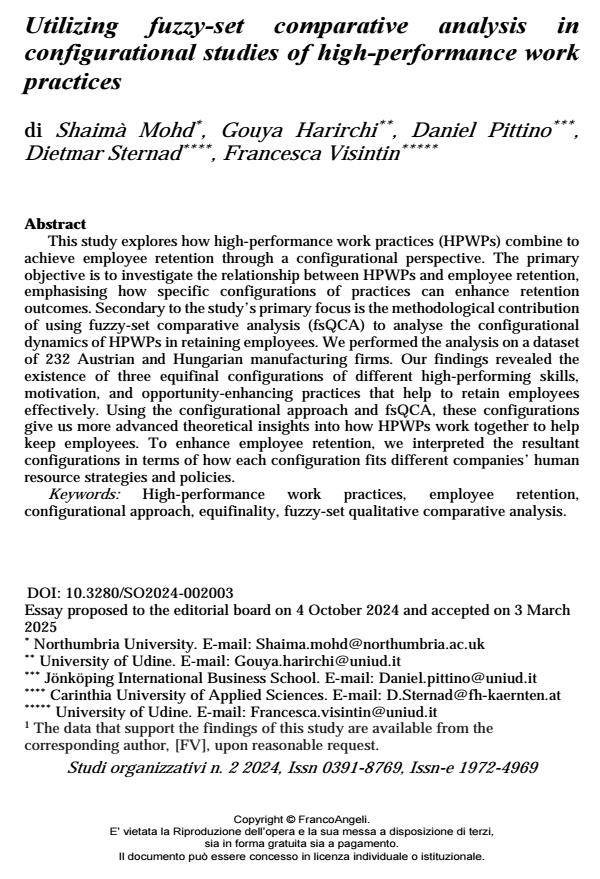Utilizing fuzzy-set comparative analysis in configurational studies of high-performance work practices
Titolo Rivista STUDI ORGANIZZATIVI
Autori/Curatori Shaimà Mohd, Gouya Harirchi, Daniel Pittino, Dietmar Sternad, Francesca Visintin
Anno di pubblicazione 2025 Fascicolo 2024/2
Lingua Inglese Numero pagine 34 P. 39-72 Dimensione file 326 KB
DOI 10.3280/SO2024-002003
Il DOI è il codice a barre della proprietà intellettuale: per saperne di più
clicca qui
Qui sotto puoi vedere in anteprima la prima pagina di questo articolo.
Se questo articolo ti interessa, lo puoi acquistare (e scaricare in formato pdf) seguendo le facili indicazioni per acquistare il download credit. Acquista Download Credits per scaricare questo Articolo in formato PDF

FrancoAngeli è membro della Publishers International Linking Association, Inc (PILA)associazione indipendente e non profit per facilitare (attraverso i servizi tecnologici implementati da CrossRef.org) l’accesso degli studiosi ai contenuti digitali nelle pubblicazioni professionali e scientifiche
This study explores how high-performance work practices (HPWPs) combine to achieve employee retention through a configurational perspective. The primary objective is to investigate the relationship between HPWPs and employee retention, emphasising how specific configurations of practices can enhance retention outcomes. Secondary to the study’s primary focus is the methodological contribution of using fuzzy-set comparative analysis (fsQCA) to analyse the configurational dynamics of HPWPs in retaining employees. We performed the analysis on a dataset of 232 Austrian and Hungarian manufacturing firms. Our findings revealed the existence of three equifinal configurations of different high-performing skills, motivation, and opportunity-enhancing practices that help to retain employees effectively. Using the configurational approach and fsQCA, these configurations give us more advanced theoretical insights into how HPWPs work together to help keep employees. To enhance employee retention, we interpreted the resultant configurations in terms of how each configuration fits different companies’ human resource strategies and policies.
L’articolo si propone di studiare come le pratiche di lavoro ad alte prestazioni (HPWP) possano combinarsi per migliorare la retention dei dipendenti. Le HPWP sono un insieme di pratiche di gestione delle risorse umane progettate per ottimizzare le competenze, la motivazione e le opportunità dei lavoratori. Il loro scopo è migliorare le prestazioni aziendali e ridurre il turnover, creando un ambiente di lavoro favorevole che incentiva la permanenza dei dipendenti. La ricerca condotta su un campione di imprese manifatturiere austriache e ungheresi ha individuato tre configurazioni "equifinali" di HPWP, ovvero combinazioni diverse di pratiche che conducono tutte al medesimo risultato positivo: la capacità dell’azienda di trattenere i propri dipendenti. Questo suggerisce che non esiste una sola "ricetta" per il successo, ma diverse configurazioni efficaci, ognuna delle quali risponde a differenti strategie aziendali e contesti organizzativi. Le implicazioni pratiche di questo studio anche per il contesto italiano offrono una guida preziosa ai responsabili HR per identificare le configurazioni ottimali di pratiche di gestione del personale in base agli obiettivi strategici dell’organizzazione, aiutando così le imprese a migliorare il proprio tasso di retention senza dover necessariamente adottare tutte le pratiche HR esistenti.
Parole chiave:Pratiche ad alte prestazioni, ritenzione dei dipendenti, approccio configurazionale, equifinalità, fuzzy-set qualitative comparative analysis.
Shaimà Mohd, Gouya Harirchi, Daniel Pittino, Dietmar Sternad, Francesca Visintin, Utilizing fuzzy-set comparative analysis in configurational studies of high-performance work practices in "STUDI ORGANIZZATIVI " 2/2024, pp 39-72, DOI: 10.3280/SO2024-002003